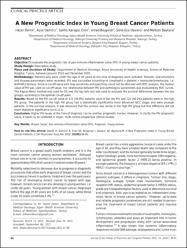| dc.contributor.author | Demir, Hacer | |
| dc.contributor.author | Demirci, Ayşe | |
| dc.contributor.author | Karagöz Eren, Saliha | |
| dc.contributor.author | Beypınar, İsmail | |
| dc.contributor.author | Davarcı, Sena Ece | |
| dc.contributor.author | Baykara, Meltem | |
| dc.date.accessioned | 2022-05-12T06:12:14Z | |
| dc.date.available | 2022-05-12T06:12:14Z | |
| dc.date.issued | 2022 | en_US |
| dc.identifier.citation | Demir, H., Demirci, A., Eren, S. K., Beypinar, I., Davarcı, S. E., & Baykara, M. (2022). A New Prognostic Index in Young Breast Cancer Patients. Journal of the College of Physicians and Surgeons--Pakistan: JCPSP, 32(1), 86-91. | en_US |
| dc.identifier.issn | 1022-386X | |
| dc.identifier.issn | 1681-7168 | |
| dc.identifier.uri | https://doi.org/10.29271/jcpsp.2022.01.86 | |
| dc.identifier.uri | https://hdl.handle.net/20.500.12933/982 | |
| dc.description.abstract | Objective:To evaluate the prognostic role of pan immune-inflammation value (PIV) in young breast cancer patients.
Study Design: Descriptive study.
Place and Duration of Study: Department of Medical Oncology, Afyon University of Health Sciences, School of Medicine Hospital, Turkey, between January 2010 and December 2020.
Methodology: Patients who were under the age of 40 years at the time of diagnosis were included. Patients’ characteristics and disease parameters were recorded. PIV was calculated according to (neutrophil x platelet x monocyte/lymphocyte, i.e. NxPxM/L) formula. Since a cut-off value with max sensitivity and specificity could not be obtained with ROC analysis, the median value of PIV was used as cut-off value. The relationship between PIV and pathological parameters was evaluated by ROC curves. The Kaplan-Meier method was used for OS and the log-rank test was used to evaluate the survival differences between the two groups, according to the optimal cut-off point.
Results: Based on the PIV cut-off value of 121 (49.8%) patients were in the low PIV and 122 (50.2%) patients were in the high PIV group. The patients in the high PIV group had a statistically significantly more advanced AJCC stage, and were younger patients. In the survival analysis, it was observed that the survival was worse in the high PIV group but this difference did not reach statistical significance (p=0.112).
Conclusion: Higher PIV levels at the time of diagnosis can be another prognostic marker. However, to clarify the PIV prognostic value, it needs to be validated in larger, multi-centre prospective clinical studies. | en_US |
| dc.language.iso | eng | en_US |
| dc.publisher | College of Physicians and Surgeons Pakistan | en_US |
| dc.relation.isversionof | 10.29271/jcpsp.2022.01.86 | en_US |
| dc.rights | info:eu-repo/semantics/openAccess | en_US |
| dc.subject | Breast cancer | en_US |
| dc.subject | Pan immune-inflammation value (PIV) | en_US |
| dc.subject | Prognosis | en_US |
| dc.subject | Young women | en_US |
| dc.title | A New Prognostic Index in Young Breast Cancer Patients | en_US |
| dc.type | article | en_US |
| dc.authorid | 0000-0003-1235-9363 | en_US |
| dc.authorid | 0000-0003-1142-9411 | en_US |
| dc.authorid | 0000-0003-3291-8134 | en_US |
| dc.department | AFSÜ, Tıp Fakültesi, Dahili Tıp Bilimleri Bölümü, İç Hastalıkları Ana Bilim Dalı | en_US |
| dc.contributor.institutionauthor | Demir, Hacer | |
| dc.contributor.institutionauthor | Davarcı, Sena Ece | |
| dc.contributor.institutionauthor | Baykara, Meltem | |
| dc.identifier.volume | 32 | en_US |
| dc.identifier.issue | 1 | en_US |
| dc.identifier.startpage | 86 | en_US |
| dc.identifier.endpage | 91 | en_US |
| dc.relation.journal | Journal of the College of Physicians and Surgeons | en_US |
| dc.relation.publicationcategory | Makale - Uluslararası Hakemli Dergi - Kurum Öğretim Elemanı | en_US |
















